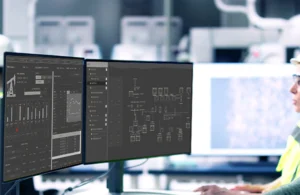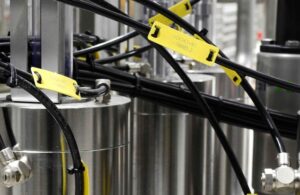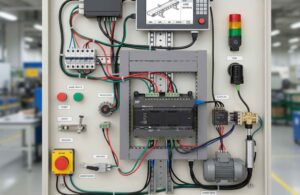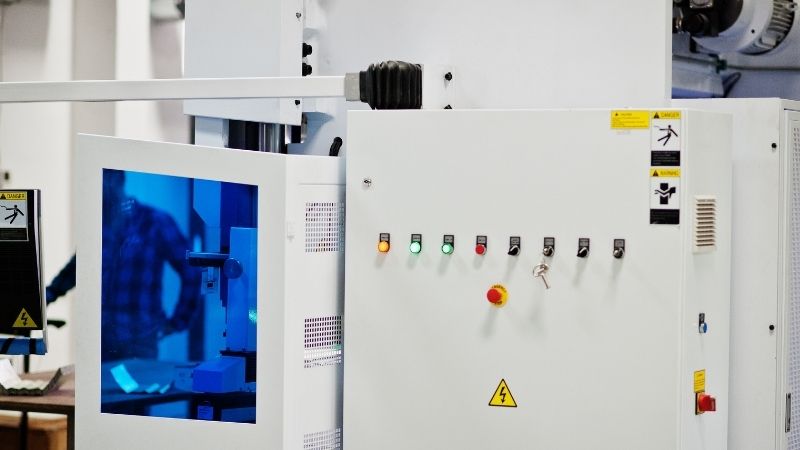RTD y termopares: sensores vitales para la automatización industrial
Ya sea que sea un técnico experimentado o nuevo en el campo, comprender las funcionalidades, ventajas y aplicaciones de estos sensores mejorará su capacidad para implementar soluciones efectivas de monitoreo de temperatura.
Tabla de contenido
¿Qué es un RTD y cómo funciona?
Los detectores de temperatura de resistencia (RTD) son detectores de temperatura de precisión sensores Se utilizan para medir la temperatura mediante la correlación de la resistencia del elemento RTD con la temperatura. Los RTD, que suelen estar hechos de platino puro, níquel o cobre, ofrecen una gran precisión y estabilidad, lo que los hace indispensables en diversas aplicaciones industriales.
Cómo mide la temperatura el RTD
Los RTD funcionan según el principio de que la resistencia eléctrica de ciertos metales cambia de manera predecible con la temperatura. A medida que aumenta la temperatura, también aumenta la resistencia del elemento RTD. Este cambio se mide y se convierte en una lectura de temperatura, a menudo mediante un SOCIEDAD ANÓNIMA Tarjeta de entrada u otros sistemas de monitoreo de temperatura.
Tipos de configuraciones de RTD
Los RTD vienen en diferentes configuraciones de cables (2, 3 y 4 cables), cada una de las cuales ofrece distintos niveles de precisión y compensación de la resistencia del cable conductor. El RTD de 3 cables se utiliza comúnmente en entornos industriales, ya que proporciona un buen equilibrio entre complejidad y precisión.
¿Cómo se comparan los RTD y los termopares en la medición de temperatura?
En lo que respecta a la detección de temperatura, los RTD y los termopares son los dos principales competidores. Comprender sus diferencias es fundamental para seleccionar el sensor adecuado para su aplicación.
Precisión y estabilidad
Los RTD son reconocidos por su precisión superior y estabilidad a largo plazo en comparación con los termopares. Por lo general, ofrecen una tolerancia de ±0,1 °C, lo que los hace ideales para aplicaciones que requieren un control preciso de la temperatura.
Rango de temperatura
Si bien los RTD son excelentes para una amplia gama de temperaturas, los termopares se destacan en la medición de temperaturas extremadamente altas o bajas, a menudo más allá del rango que los RTD pueden manejar. Por ejemplo, los termopares tipo K pueden medir temperaturas de hasta 1800 °C, mientras que los RTD generalmente están limitados a alrededor de 850 °C.
Tiempo de respuesta
Los termopares generalmente tienen un tiempo de respuesta más rápido debido a su construcción más simple, lo que los hace adecuados para procesos dinámicos donde es necesario detectar rápidamente cambios rápidos de temperatura.
¿Qué factores influyen en la tolerancia de los sensores RTD?
La tolerancia de un sensor RTD se refiere a su precisión y confiabilidad en la medición de la temperatura. Varios factores pueden influir en la tolerancia de un RTD, lo que garantiza un control preciso de la temperatura.
Calidad del material
La pureza del elemento RTD, que suele ser platino, afecta significativamente su tolerancia. Los materiales de alta pureza presentan cambios de resistencia más predecibles con la temperatura, lo que mejora la precisión.
Calibración
La calibración periódica garantiza que los sensores RTD mantengan su precisión a lo largo del tiempo. La calibración implica comparar las lecturas del RTD con estándares de temperatura conocidos y realizar los ajustes necesarios.
Condiciones ambientales
Factores como el ruido eléctrico, las vibraciones y la temperatura ambiente pueden afectar el rendimiento del RTD. Las prácticas adecuadas de protección e instalación ayudan a mitigar estos efectos, manteniendo la tolerancia del sensor.
¿Qué papel juegan los cables en el rendimiento del sensor RTD?
El cableado de un sensor RTD desempeña un papel fundamental para garantizar mediciones de temperatura precisas. La cantidad de cables y su calidad pueden influir en el rendimiento y la confiabilidad del sensor.
Configuración de cables
Los RTD están disponibles en configuraciones de 2, 3 y 4 cables:
- Los RTD de 2 cables son los más simples pero son más susceptibles a errores debido a la resistencia del cable conductor.
- Los RTD de 3 cables ofrecen una mejor compensación de la resistencia del cable conductor, lo que proporciona una precisión mejorada.
- Los RTD de 4 cables ofrecen la máxima precisión al eliminar por completo la resistencia del cable conductor de la medición.
Material y calidad del alambre
El uso de cables de platino de alta calidad garantiza cambios mínimos de resistencia no relacionados con las variaciones de temperatura. Además, el blindaje adecuado de los cables puede evitar que el ruido eléctrico afecte las lecturas del sensor.
Prácticas de instalación
Una instalación adecuada, incluido el uso de pozos térmicos, puede proteger el sensor RTD de los factores ambientales y el estrés mecánico, preservando la integridad de las conexiones de cables y el rendimiento general del sensor.
¿Cómo se integran los PLC con los sensores RTD en la automatización industrial?
Controladores lógicos programables (PLC) Son parte integral de los sistemas de automatización industrial modernos y su perfecta integración con los sensores RTD es esencial para un control y monitoreo de temperatura efectivos.
Conexión de RTD a PLC
Los sensores RTD se conectan a los PLC a través de tarjetas de entrada diseñadas para interpretar los cambios de resistencia del RTD y convertirlos en datos de temperatura significativos. Estos módulos de entrada suelen tener capacidades de entrada analógica para gestionar la naturaleza continua de las mediciones de temperatura.
Tratamiento y control de datos
Una vez conectado, el PLC procesa los datos de temperatura para tomar decisiones en tiempo real. Por ejemplo, si la temperatura supera un punto de ajuste establecido, el PLC puede activar acciones como sistemas de refrigeración o ajustar las velocidades del motor para mantener las condiciones óptimas.
Mejorar la confiabilidad del sistema
La integración de RTD con PLC permite estrategias de control y monitoreo sofisticadas, mejorando la confiabilidad y eficiencia generales de los procesos industriales. Además, los PLC pueden registrar datos de temperatura para fines de calibración y mantenimiento predictivo, lo que reduce el tiempo de inactividad y los costos operativos.
Preguntas frecuentes
¿Cuál es la principal ventaja de utilizar un RTD en lugar de un termopar?
Los RTD ofrecen mayor precisión y mejor estabilidad a largo plazo en comparación con los termopares, lo que los hace ideales para aplicaciones que requieren mediciones de temperatura precisas.
¿Cómo afecta la configuración del cable al rendimiento del RTD?
La configuración de los cables (2, 3 o 4 cables) afecta la precisión de las lecturas de temperatura al compensar la resistencia de los cables conductores. Por lo general, cuanto más cables haya, mejor será la precisión.
¿Pueden los RTD medir temperaturas extremadamente altas como los termopares?
Los RTD tienen un rango de temperatura más limitado en comparación con los termopares. Si bien son adecuados para la mayoría de las aplicaciones industriales, los termopares son los preferidos para medir temperaturas muy altas o muy bajas.
¿Con qué frecuencia se deben calibrar los sensores RTD?
Se recomienda una calibración regular para mantener la precisión, generalmente anualmente o según lo especifique el fabricante o los estándares de la industria.
Potencie sus proyectos con PLC Omron, Mitsubishi y Schneider nuevos y originales: ¡en stock y listos ahora!
Conclusión
- Los RTD son sensores de temperatura altamente precisos y estables, ideales para aplicaciones industriales precisas.
- Los termopares ofrecen un rango de temperatura más amplio y tiempos de respuesta más rápidos, pero son menos precisos que los RTD.
- La configuración del cable (2 cables, 3 cables, 4 cables) juega un papel importante en la precisión de las mediciones de RTD.
- Los PLC se integran perfectamente con los sensores RTD, lo que permite un control y monitoreo de temperatura sofisticados en sistemas de automatización.
- La calibración regular y las prácticas de instalación adecuadas son esenciales para mantener la precisión y confiabilidad de los sensores RTD.
Al comprender las funcionalidades y aplicaciones de los RTD y termopares, los profesionales del sector de la automatización industrial pueden tomar decisiones informadas para mejorar sus sistemas de monitoreo de temperatura, asegurando eficiencia y confiabilidad en sus operaciones.
¿Buscas PLC nuevos y originales para tus proyectos? En Kwoco, tenemos en stock los PLC más recientes de las mejores marcas como Omrón, Mitsubishi, y SchneiderCompre con confianza: envío rápido, calidad garantizada. ¡Compre ahora!
Contáctenos
Simplemente complete su nombre, dirección de correo electrónico y una breve descripción de su consulta en este formulario. Nos comunicaremos con usted dentro de las 24 horas.
Categoría de producto
Productos en oferta
También te pueden interesar estos temas

Cómo se comunican eficientemente los sistemas PLC y SCADA
¿Cómo garantizan las fábricas que todos los equipos estén sincronizados, que los datos fluyan sin problemas y que se maximice la eficiencia? Aquí es donde trabajan juntos el PLC y el SCADA.

Sensores NPN y PNP: explicación de las diferencias clave
Comprender las diferencias entre los sensores NPN y PNP es fundamental para cualquier persona involucrada en la automatización industrial. Estos sensores son componentes fundamentales en los sistemas de control y saber cómo funcionan puede mejorar en gran medida la eficiencia y la confiabilidad de sus operaciones. Esta guía completa desmitificará los módulos y sensores NPN y PNP, explicará su funcionalidad y lo ayudará a decidir qué tipo es el más adecuado para sus aplicaciones.

Una guía completa sobre los tipos de PLC y sus características clave
Los controladores de razonamiento programable (PLC) se han convertido en la base de la automatización industrial, ofreciendo fiabilidad, versatilidad y eficiencia en los sistemas de control. Este breve artículo explica los fundamentos de los PLC, su clasificación, ventajas y futuras tendencias de desarrollo.






